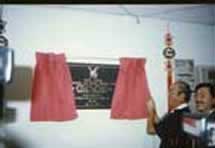THE TOLE |
|
|||||||||||
| LIVER PROBLEM | |||||||||||
|
|||||||||||
People who have hepatitis B or C (viral infections of the liver) or a disease of the liver called cirrhosis are more likely than other people to get adult primary liver cancer. Primary liver cancer is different from cancer that has spread from another place in the body to the liver. A doctor should be seen if the following symptoms appear: a hard lump just below the rib cage on the right side where the liver has swollen, discomfort in the upper abdomen on the right side, pain around the right shoulder blade, or yellowing of the skin (jaundice). If there are symptoms, a doctor may order special x-rays, such as a computed tomographic scan or a liver scan. If a lump is seen on an x-ray, a doctor may use a needle inserted into the abdomen to remove a small amount of tissue from the liver. This procedure is called a needle biopsy, and a doctor usually will use an x-ray for guidance. The doctor will have the tissue looked at under a microscope to see if there are any cancer cells. Before the test, a patient will be given a local anesthetic (a drug that causes loss of feeling for a short period of time) in the area so that no pain is felt. A doctor may also want to look at the liver with an instrument called a laparoscope's, which is a small tube-shaped instrument with a light on the end. For this test, a small cut is made in the abdomen so that the laparoscope's can be inserted. The doctor may also take a small piece of tissue (biopsy specimen) during the laparoscope's and look at it under the microscope to see if there are any cancer cells. An anesthetic will be given so no pain is felt. A doctor may also order an examination called an angiography's. During this examination, a tube (catheter) is inserted into the main blood vessel that takes blood to the liver. Dye is then injected through the tube so that the blood vessels in the liver can be seen on an x-ray. Angiography's can help a doctor tell whether the cancer is primary liver cancer or cancer that has spread from another part of the body. This test is usually done in the hospital. Certain blood tests (such as alpha-fetoprotein, or AFP) may also help a doctor diagnose primary liver cancer. The chance of recovery (prognosis) and choice of treatment depend on the stage of the cancer (whether it is just in the liver or has spread to other places) and the patient's general state of health. |
|||||||||||
| Stages of adult primary liver cancer: | |||||||||||
Once adult primary liver cancer is found, more tests will be done to find out if the cancer cells have spread to other parts of the body (staging). The following stages are used for adult primary liver cancer: Localized resectable: Cancer is found in one place in the liver and can be totally removed in an operation. Localized unresectable: Cancer is found only in one part of the liver, but the cancer cannot be totally removed. Advanced: Cancer has spread through much of the liver or to other parts of the body, name secondary cancer. Recurrent: Recurrent disease means that the cancer has come back (recurred) after it has been operated if you can stand a change for it which is slim. It may come back in the liver or in another part of the body. |
|||||||||||
| Liver Cancer by stage | |||||||||||
| Liver Cancer for adult primary liver cancer depend on the stage of the disease the condition of the liver, and the patient's age and general health that is the others organ's Qi lever. Standard treatment may be considered, based on its effectiveness in patients in past studies, or participation into a clinical trial. Many patients are not treated with standard therapy, and some standard treatments may have many more side effects than are desired. For these reasons, clinical trials are designed to find better ways to treat cancer patients and are based on the most up-to-date information. | |||||||||||
| Liver Cancer | |||||||||||
Two ways in which cancer can involve the liver. The cancer can arise from the liver itself (primary liver cancer) or it can spread to the liver from a primary tumor at another site (secondary, or metastasis, cancer). In the UK, secondary liver cancer is about 28 times more common than primary liver cancer. Each year there are about 70,000 patients in the UK with secondary liver cancer and about 2,500 with primary liver cancer. Primary liver cancer can arise from the liver cells themselves (hepatocellular carcinoma) or from the system of tubes that drains the bile from the liver (cholangiocarcinoma, gall bladder cancer). Most patients with primary liver cancer have suffered previously from liver disease such as chronic hepatitis, cirrhosis or, in the less developed world, been exposed to poisons. Secondary (metastasis) cancer reaches the liver by spreading through the blood system from a primary tumor at a separate site. In about 50 per cent of patients with metastasis liver cancer, the primary tumor is in the bowel (colon, rectum) or stomach. The other common primary sites are the breasts and lungs. |
|||||||||||
| The symptoms of cancer involving the liver can include: | |||||||||||
|
|||||||||||
Primary liver cancer is difficult to treat. Surgical removal not recomended option , these tumours are often too large and too extensive for surgery. Chemotherapy is occasionally used for inoperable tumours but any benefit is unsual. Unfortunately, survival rates for primary liver cancer are low in western treatment. Treatment of secondary (metastatic) liver cancer is determined by the site of origin of the original (primary) tumour. It is important to realise that the tumour, even though it has spread to the liver, will still behave according to its origin. A leopard does not change its spots: breast cancer involving the liver behaves like breast cancer, notlike primary liver cancer. Consequently the outlook can be rather better for patients with secondarly if you are lucky. Surgery is increasingly being used for patients with secondary liver cancer. This can sometimes involve removing a segment of liver. If it is sucessful you may have 2 or more years of life when you are lucky, or not at all. If it is not susessfull you may be finish instantly. Presence of secondary cancer within the liver implies that the primary tumour has spread via the bloodstream and as a result other organs may be at risk. Modern conventional radiotherapy has little role to play in the management of liver cancer, whether primary or secondary. Specialised techniques, involving the temporary placement of radioactive wires, can be used to treat certain primary cancers of the ducts within, or immediately adjacent to, the liver. Liver transplantation is not usually a viable option for patients with cancer involving the liver - the cancer has often spread beyond the liver itself and the medicines used to suppress the immune system after the transplant can stimulate the growth of any remaining cancer cells. |
|||||||||||
|
|
|||||||||||||||||||||||||||||||





